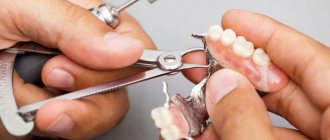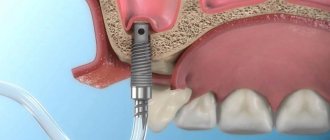Implantation without an incision is a marketing name that reflects the meaning of the procedure. This type of implant installation is also called transgingival, endoscopic, non-surgical or bloodless. This treatment is known in Europe 15 years, in Russia - relatively recently, but the popularity of the method is growing.
The process of installing an implant without an incision
What is implantation without a gum incision?
First, let's figure out what classical implantation is. This protocol involves the introduction of a titanium root (implant) into the bone tissue at the site of the missing tooth. The surgeon acts like this:
- Cuts the mucous membrane.
- Folds back the gingival flap.
- If necessary, it builds up bone tissue.
- Places an implant.
- Places stitches.
- After the implant has healed, a permanent crown is installed.
Tooth restoration takes 5-6 months , since it requires healing of the gums, fusion of the implant with the bone tissue, and installation of a crown after osseointegration.
Unlike the classical method, implantation without incisions allows you to skip several stages and avoid large incisions in the gums:
- To install the implant, one hole with a diameter of several millimeters is made.
- The implant is implanted.
- A gum former or temporary lightweight crown is immediately installed.
- After the implant has healed, a permanent crown is fixed in 2-3 months .
This treatment is recommended:
- people with diseases of the endocrine and cardiovascular systems;
- for those who are against surgery.
The bloodless method accelerates the restoration of the dentition.
Is it possible to get implants without surgery?
With the classic implantation protocol, the patient is given a local anesthesia to ensure that the procedure is completely painless. Next, the implantologist folds back a triangular flap of the mucosa, forms a special bed and inserts the implant. The mucous membrane is returned to its place, fixed with self-absorbing sutures. Those who are frightened by such a description of implantation are looking for options on how to do without incisions.
Among the available technologies, we can highlight the use of a special knife, which cuts out a cylindrical depression at the implant installation site. In this case, after implantation, sutures are not placed on the gums.
PROMOTION
Osstem dental implantation turnkey
18,000 rub.
Features of the method
The method is not suitable for patients with bone deficiency for reliable fixation of an artificial rod. It is impossible to increase bone mass without making an incision in the gums, so non-surgical treatment is available to only 5% of people.
The volume of the mucous membrane is also taken into account. If the gum thickness is less than 2 mm, an implant cannot be installed using a non-surgical method. Under the influence of the titanium root, the mucous membrane will stretch and become even thinner. The thinner the gums, the greater the risk of inflammatory processes and implant rejection. The fact is that opportunistic bacteria, which are normally found in the oral cavity, can seep through the thin soft tissue and destroy the bone underneath. For thinned gums, we recommend enlarging the incision and performing implantation using a patchwork method.
In our Center, implantation without incisions is not covered by a lifetime guarantee.
Related articles:
- Other implantation methods
- Our guarantees
- Implant lifespan
Compliance with conditions
Dental implantation
non-surgical method, or as it is also called, transgingival, has contraindications:
- Inflammatory process in the periodontal area (exacerbation);
- Insufficient tissue volume - bone and soft;
- Poor bone quality in the area where the tooth is missing;
- Poor performance of primary implant stabilization.
Contraindications can be relative and absolute, general and local, and are temporary. For more details, it is better to consult your doctor!
We must not forget that despite the huge number of advantages, this is still an operation. This means that you need to take a responsible approach to choosing a dentist. A competent implantologist will assess all possible risks.
Implantation using the incisionless technique: absolute contraindications:
- Diseases of the blood and hematopoietic organs;
- Mental problems;
- Connective tissue diseases;
- Malignant tumors;
- Tuberculosis, including complicated;
- Poor immunity;
- Diabetes;
- Bruxism;
- Allergy to drugs used;
- Endocrine disorders;
- Osteoporosis.
Relative contraindications:
- Caries;
- Poor oral hygiene;
- Pathological bite;
- Inflammation of the gums;
- Arthrosis of the jaw joints;
- Periodontitis;
- Pregnancy;
- Smoking, alcoholism, drug addiction;
- Atrophied alveolar processes of teeth.
Relative means contraindications that can be overcome.
What does smoking have to do with it? A smoker is more likely to experience implant failure than the average person. This is why it is recommended to give up cigarettes two weeks before the procedure.
General contraindications:
- Allergy to anesthetics;
- General somatic diseases;
- Taking medications prescribed by other doctors;
- Unstable psychological state due to stress;
- Exhaustion.
Local contraindications:
- Bone atrophy in the area where the implant is planned to be placed;
- The gap between the working area and the maxillary and nasal sinuses is too small.
- Temporary contraindications:
- Diseases in the acute stage;
- Rehabilitation period;
- Recent radiation therapy;
- Alcoholism.
Stages of bloodless implantation
With the seamless method, the implant is inserted through a puncture of the gum. Before the puncture, local anesthesia is given or the patient is put into medicated sleep.
- Using a circular mucotome, a circular incision is made for the titanium root. Preparing the hole begins by marking it with a ball bur. Sequential expansion is carried out using cutters of different diameters - from smaller to larger.
- Installation of an artificial root into the bone mass by screwing.
- Fixation of the healing abutment or abutment.
- It is possible to install a temporary lightweight crown immediately. After osseointegration, it is replaced with a permanent one.
Indications and contraindications
Implantation of an artificial root is used to restore lost teeth. Indications for use of the procedure:
- Missing one or more teeth;
- The need for rapid recovery;
- Absence of extreme dental units;
- Edentia.
Non-surgical dental implantation has a number of contraindications. It is strictly forbidden to carry out the procedure for people suffering from diseases of the gums, oral cavity, internal organs and circulatory system. It is not allowed to carry out the process of installing implants on patients who have been diagnosed with malignant processes in the body. In addition, contraindications apply to pregnant and breastfeeding women.
Features of the operation in our Center
- We begin transgingival implantation by creating a 3D model of the jaw. Our Center uses the “Nobel Guide” system. She creates an accurate virtual model based on mathematical calculations and produces a surgical template. With it, the doctor will determine where and at what distance to place the implants without cutting the gums. A tomograph and an X-ray machine do not provide such accuracy. The very name “implantation without incision” was invented by marketers to promote the “Nobel Guide” protocol.
- When the surgical template is ready, the doctor places it firmly against the gum and makes one or more holes for the implants. The procedure is performed under local anesthesia or sedation and is painless for the patient.
- After inserting the rod, the doctor places a temporary crown if the tooth is in the smile zone.
- After 2-3 months, the patient comes to the clinic for the second time and leaves with a permanent crown, indistinguishable from a natural tooth. In classical technology, the last visit takes place six months after the start of treatment.
How new dental implants are made and inserted if they cannot be placed without bone grafting
Dental plastic surgery involves increasing the volume of soft tissue on the gums when they are not enough. There are two ways to do this:
- Immediately transplant soft tissue if there are no contraindications during surgery.
- Natural growing and dividing the surgical procedure into two parts a few months apart.
This formation is necessary to give the jaw an attractive appearance and adjust the future smile accordingly. This issue becomes especially relevant when it comes to the front incisors, which are always in sight.
Rehabilitation period
Rehabilitation with the sutureless method takes less time compared to classical implantation. The operation is minimally invasive, without stitches, and therefore the implants take root quickly.
The risk of complications is minimal, since surgical manipulations practically do not injure fibrous tissue. But this does not mean that in the postoperative period the patient should not follow a certain regimen:
- On the recommendation of a doctor, antibacterial therapy, anti-inflammatory and painkillers are prescribed.
- On the first day you should not eat solid food.
- On the second day, if there is no pain, swelling and temperature, the gentle regime and anti-inflammatory drugs are canceled.
In what cases is bone grafting required?
It is impossible to successfully install dental implants without bone augmentation in the following situations:
- The patient is missing several teeth in a row and there is severe atrophy of the jaw bone in height, width, or width and height at the same time.
- For severe forms of periodontitis.
Important!
If bone atrophy is so great that there is a high probability of damage to the maxillary sinus and mandibular nerve, and the use of short and narrow implants increases the risk of rejection of the structure, not a single doctor will install implants without first building up the bone.
To find out whether bone grafting is required in your case, sign up for a free consultation at any of the NovaDent clinics in Moscow and the Moscow region.
Expert of the article you are reading: Griboyedov Pavel Olegovich Implantologist, Orthopedic Dentist, leading specialist of the NovaDent network
14 years
Clinical experience
Skhodnenskaya
Khimki Boulevard, 14, bldg. 2
+7
Free consultation with this specialist
Benefits of non-surgical implant installation
- The time to restore the dentition is reduced: after a maximum of 3 months, the patient is fitted with a permanent crown.
- The operation is faster: installing the rod using the classical method takes up to 8 minutes, and using the bloodless method – up to 2 .
- Rehabilitation is made easier: patients do not experience bruises, swelling, pain, or fever, and can work the next day after the implants are installed. It is especially important when restoring several teeth.
- The risk of implant rejection and infection is reduced since it does not require separation of the gum from the bone.
- Takes 10-15 minutes . Unlike the classic 3-stage method, with a non-surgical method the doctor installs a gum former or temporary crown immediately, without waiting for healing. The rehabilitation period is reduced by 2-2.5 times .
Traditional and transgingival implantation
Traditional implant placement is very traumatic. Installation of the product and the adaptation period require a lot of time, so experts prefer the non-surgical method of implanting dental structures. Traditional pin installation consists of the following steps:
- The specialist eliminates existing dental problems (tartar, caries, periodontal disease). After this, an implant is selected and an impression of the jaw is made. An incision is made on the periosteum and mucous membrane to introduce a bed under the product.
- After the operation, you must adhere to all the specialist’s instructions. As a rule, the patient is prescribed antibacterial and anti-inflammatory drugs and rinsing the mouth with antiseptic drugs.
- Osseointegration of the product lasts six months, then the specialist installs the abutment and temporary crown. After this, the doctor recommends coming back in two weeks. If during this period the healing process is successful, then a permanent crown or prosthesis is placed.
When dental implants are installed without a gum incision, this significantly reduces the healing time - the product takes from one to two months. In addition, there is no trauma or damage to the jaw nerve.
Price
Speed of the procedure does not mean cheaper. The amount of consumables and the cost of doctors’ work does not decrease. On the contrary, the price of implantation without an incision is higher due to:
- manufacturing a surgical template;
- mandatory three-time computed tomography.
The cost of a case for treatment is from 60,000 rubles . The amount includes the necessary procedures, the patient will not have to pay extra. For comparison, in Moscow clinics the price of the procedure starts at 45,000 rubles, but usually this amount is not final.
What is the cost of dental implants without surgery?
The average price of dental implantation without surgery is initially slightly higher than the classic one. However, the final cost of treatment using the transgingival method is several times cheaper, since its use does not require such additional and rather expensive manipulations as, for example, patch surgeries.
There is a stereotype among patients and some doctors that a good implant must be expensive. However, this statement is not always true. The implant is selected based on the individual characteristics of the body - in particular, depending on the density and volume of the jaw bone. The designs of different implant systems differ from each other, and sometimes a budget implant is more suitable for a patient than a premium product. In addition, thanks to diagnostics, the clinic can tell the patient the final cost of treatment in advance, which is undoubtedly a big advantage.
Options for implantation without incision
Implantation without surgery can be conditionally called 2 more types:
- Laser - a laser beam is used instead of a scalpel. The bloodless incision of the gum is accurate, while at the same time disinfecting the area and minimizing the wound healing time is ensured.
- Instantaneous immediately after tooth extraction - there is no need to make incisions in the gums, since the implant is implanted into a fresh socket. But it is not always possible to carry out the extraction carefully, and the disfigured socket is not suitable for installing an implant.
Contraindications to implantation, which may cause pain
Contraindications to implant installation include:
- diabetes mellitus in the stage of decompensation;
- oncological diseases treated using chemotherapy and radiation therapy;
- thyroid diseases;
- smoking;
- diseases of the oral cavity.
In the presence of these pathologies, not only the process of installing artificial structures, but also their engraftment may become problematic and can lead to painful complications.
In all of the above situations, you must definitely consult with your dentist and do all the necessary diagnostic tests to make sure there are no obstacles to implantation. However, if you have no contraindications, you should not be afraid of the painfulness of the procedure, because modern implantation is an effective, time-tested and safe method of prosthetics!
An implant installed by an experienced specialist will last quite a long time – about 20 years. It is quite possible to carry out the procedure in one visit to the dental clinic. Provided that the patient’s oral cavity does not require sanitation and he is absolutely healthy.
Types of non-surgical implantation
Transgingival The doctor determines the exact location of the implants using a computed tomogram, makes a circular puncture in the gum using a mucotome and screws the titanium root into the bone.
Laser The gingival incision is made with a laser, which quickly cauterizes the vessels, prevents bleeding and disinfects the surface of the wound.
Single-stage The implant is implanted into the hole formed after the removal of a dental unit, no additional incisions are made
Typically, the non-surgical technique is used with a one-stage protocol - prosthetics are organized immediately after implantation.
How is rehabilitation going: what to do
The postoperative period is always accompanied by recovery measures that promote a speedy recovery.
In the first days, it is not recommended to even rinse your mouth. This will wash away the blood molecules that are responsible for wound healing. To maintain hygiene, you can gently clean, including the temporary crown. For this, soft brushes are used, and movements should be very smooth and careful. It is better to choose a paste with antiseptic additives.
Sauna, solarium, bathhouse, heavy lifting and excessive stress are completely contraindicated during this period. The appearance of any, even the most fleeting, unpleasant sensations indicates the need to see a dentist.











